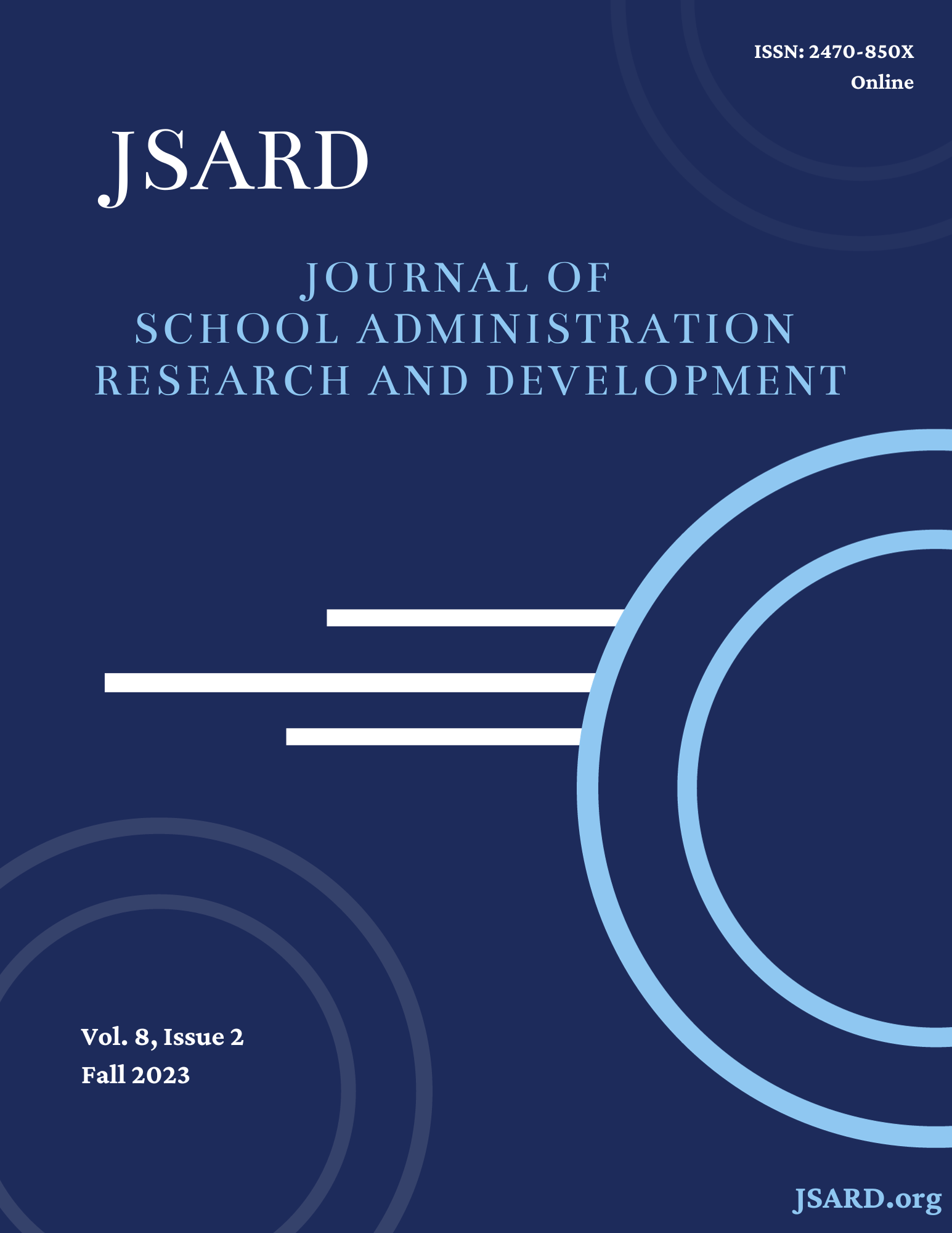From Crisis to Adaptation
The Function of Transformative Leadership Conversation
DOI:
https://doi.org/10.32674/jsard.v8i2.4482Keywords:
Adaptive Leadership, Transformation, Transformative Leadership Conversation, adaptation, leadershipAbstract
This essay is in response to the need for schools to move from crisis to adaptation. The essay is informed by the question: how might school leaders use conversation to effectively engage adaptation? Adaptation is about transforming systems. We find that with adaptation as the aim, Transformative Leadership Conversation can be used to guide schools from crisis response to adaptation. The essay lays out suggestions in a theory of action for how school leaders can use conversation to move from crisis to adaptation. These suggestions include the use of framing, questioning, and listening.
Downloads
References
Ancona, D. (2011). Sensemaking: Framing and acting in the unknown. In S.A. Snook, N. N. Nohria, & R.Khurana (Eds.), The handbook for teaching leadership, (pp. 3‒20). Sage.
Argyris, C. (2008). Learning in organizations. In T. G. Cummings (Ed.), Handbook of Organization Development (pp. 53-68). Sage.
Berger, W. (2014). A more beautiful question: The power of inquiry to spark breakthrough ideas. Bloomsbury Publishing.
Bohm, D. (1986). On dialogue. Routledge. DOI: https://doi.org/10.1007/978-3-662-01168-3_22
Brearley, L. (2015). Deep listening and leadership: An Indigenous model of leadership and community development in Australia. In C. Voyageur, L. Brearley, & B. Calliou (Eds.), Restorying Indigenous leadership: Wise practices in community development (2nd ed.), (pp. 91-127). Banff Centre Press.
Brooks, A. K., & John, L. K. (2018). The surprising power of questions. Harvard Business Review, 96(3), 60–67.
Cook, S. N., & Yanow, D. (2011). Culture and organizational learning. Journal of Management Inquiry, 20(4), 362-379. DOI: https://doi.org/10.1177/1056492611432809
Doyle, A. (2017). Adaptive challenges require adaptive leaders. Performance Improvement, 56(9), 18-26. DOI: https://doi.org/10.1002/pfi.21735
Edmondson, A. C. (2002). The local and variegated nature of learning in organizations: A group-level perspective. Organization Science, 13(2), 128-146. DOI: https://doi.org/10.1287/orsc.13.2.128.530
Fairhurst, G. T. (2005). Reframing the art of framing: Problems and prospects for leadership. Leadership, 1(2), 165-185. DOI: https://doi.org/10.1177/1742715005051857
Floyd, J. (2010). Provocation: Dialogic listening as reachable goal. The Intl. Journal of Listening, 24(3), 170-173. DOI: https://doi.org/10.1080/10904018.2010.513650
Garvin, D.A. (2000). Learning in action: A guide to putting the learning organization to work. Harvard Business Press.
Isaacs, W. N. (2001). Toward an action theory of dialogue. International Journal of Public Administration, 24(7&8), 709-748. DOI: https://doi.org/10.1081/PAD-100104771
Lederach, J. P. (2005). The moral imagination: The art and soul of building peace. Oxford University Press. DOI: https://doi.org/10.1093/0195174542.001.0001
Marshak, R. J. (2004). Generative Conversations. OD Practitioner, 36(3), 25-29.
Mezirow, J. (1994). Understanding transformation theory. Adult Education Quarterly, 44(4), 222-232. DOI: https://doi.org/10.1177/074171369404400403
Mezirow, J. (2008). An overview of transformative learning. In P. Sutherland & J. Crowther (Eds.), Lifelong learning: Concepts and contexts (pp. 24-38). Routledge.
Murphy, K. (2019). You are not listening: What you’re missing and why it matters. Celadon.
Palmer, P. J. (1998). The courage to teach: Exploring the inner landscape of a teacher’s life. Jossey-Bass.
Palmer, P. J. (2014). Healing the heart of democracy: The courage to create a politics worthy of the human spirit. Jossey-Bass.
Ramalingam, B., Nabarro, D., Oqubuy, A., Carnall, D., & Wild, L. (2020). Principles to guide adaptive leadership. Harvard Business Review.
Rohr, R. (2020). The wisdom pattern: Order, disorder, reorder. Franciscan Media.
Ryan, R. M., & Deci, E. L. (2020). Intrinsic and extrinsic motivation from a self-determination theory perspective: Definitions, theory, practices, and future directions. Contemporary Educational Psychology, 61, 1-11. DOI: https://doi.org/10.1016/j.cedpsych.2020.101860
Sarta, A., Durand, R., Vergne, J. (2021). Organizational adaptation. Journal of Management, 47(1), pp. 43-75. DOI: https://doi.org/10.1177/0149206320929088
Schein, E. H. (2003). On dialogue, culture, and organizational learning. Reflections: The SoL Journal, 4(4), 27-38. DOI: https://doi.org/10.1162/152417303322004184
Schon, D. A. (1983). The reflective practitioner. Basic Books.
Weick, K. E. (1995). Sensemaking in organizations. Sage.
Weick, K. E., Sutcliffe, K. M., & Obstfeld, D. (2005). Organizing and the process of sensemaking. Organization Science, 16(4), 409–21. DOI: https://doi.org/10.1287/orsc.1050.0133
Yukl, G., & Mahsud, R. (2010). Why flexible and adaptive leadership is essential. Consulting Psychology Journal, 62(2), 81-93. DOI: https://doi.org/10.1037/a0019835
Downloads
Published
Issue
Section
License
Copyright (c) 2023 Journal of School Administration Research and Development

This work is licensed under a Creative Commons Attribution-NonCommercial-NoDerivatives 4.0 International License.
All published articles are licensed under a Creative Commons Attribution-NonCommercial-NoDerivs 4.0 Unported License.


.png)
